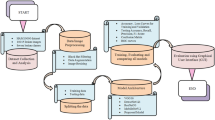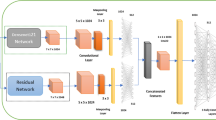Abstract
Skin lesion detection and classification is always observed as a difficult problem to solve. Manual detection of skin lesions via visual image inspection can be time-consuming and tedious. Automatic diagnosis and classification are considered a critical problem to solve because of the involvement of many factors like different image sizes, hairs in the image, bad color schemes, ruler marker, low-contrast, variation in lesion sizes, and gel bubble. Different methodologies were proposed by the researchers in the Dermatology Pigmented lesion classification. Researchers work on the binary class problem for the detection of Melanocytic lesions from the normal one. This study makes use of the MNIST HAM10000 dataset published by International Skin Image Collaboration. The dataset consists of seven classes of skin cancer diseases. Furthermore in this research, our stacked CNN model proves its superiority by achieving 95.2% accuracy along with data augmentation and image preprocessing techniques.












Similar content being viewed by others
Explore related subjects
Discover the latest articles, news and stories from top researchers in related subjects.Data availability
The datasets generated during and/or analysed during the current study are not publicly available due to Third Party Involvement (Kaggle) for the generation of the dataset. The dataset is available from the corresponding author on reasonable request.
References
Adegun A, Viriri S (2021) Deep learning techniques for skin lesion analysis and melanoma cancer detection: a survey of state-of-the-art. Artif Intell Rev 54:811–841
Akram T, Khan MA, Sharif M, Yasmin M (2018) Skin lesion segmentation and recognition using multichannel saliency estimation and m-svm on selected serially fused features. J Ambient Intell Human Comput. https://doi.org/10.1007/s12652-018-1051-5
Alexandrov LB, Kim J, Haradhvala NJ, Huang MN, Ng AWT, Wu Y, Boot A, Covington KR, Gordenin DA, Bergstrom EN et al (2020) The repertoire of mutational signatures in human cancer. Nature 578(7793):94–101
Ali ARA, Deserno TM (2012) A systematic review of automated melanoma detection in dermatoscopic images and its ground truth data. In: Medical Imaging 2012: Image Perception, Observer Performance, and Technology Assessment, International Society for Optics and Photonics, vol 8318, p 83181I
Argenziano G, Soyer HP (2001) Dermoscopy of pigmented skin lesions-a valuable tool for early. Lancet Oncol 2(7):443–449
Arora R, Raman B, Nayyar K, Awasthi R (2021) Automated skin lesion segmentation using attention-based deep convolutional neural network. Biomed Signal Process Control 65:102358. https://doi.org/10.1016/j.bspc.2020.102358
Bachert SE, McDowell A, Piecoro D, Baldwin Branch L (2020) Serous tubal intraepithelial carcinoma: a concise review for the practicing pathologist and clinician. Diagnostics 10(2):102
Baig R, Bibi M, Hamid A, Kausar S, Khalid S (2020) Deep learning approaches towards skin lesion segmentation and classification from dermoscopic images—a review. Curr Med Imaging 16(5):513–533
Bergeron S, Arthurs B, Sanft D, Mastromonaco C, Burnier M Jr (2020) Optical coherence tomography of peri-ocular skin cancers: an optical biopsy. Ocular Oncol Pathol. https://doi.org/10.1159/000511188
Bissoto A, Perez F, Ribeiro V, Fornaciali M, Avila S, Valle E (2018) Deep-learning ensembles for skin-lesion segmentation, analysis, classification: Recod titans at isic challenge 2018. arXiv preprint arXiv:180808480
Christlein V, Spranger L, Seuret M, Nicolaou A, Kral P, Maier A (2019) Deep generalized max pooling. In: Proceedings of the International Conference on Document Analysis and Recognition, ICDAR, https://doi.org/10.1109/ICDAR.2019.00177
Codella NC, Nguyen QB, Pankanti S, Gutman DA, Helba B, Halpern AC, Smith JR (2017) Deep learning ensembles for melanoma recognition in dermoscopy images. IBM J Res Dev 61(4/5):5–1
Codella N, Cai J, Abedini M, Garnavi R, Halpern A, Smith JR (2015) Deep learning, sparse coding, and SVM for melanoma recognition in dermoscopy images. In: International workshop on machine learning in medical imaging, Springer, pp 118–126
Codella N, Rotemberg V, Tschandl P, Celebi ME, Dusza S, Gutman D, Helba B, Kalloo A, Liopyris K, Marchetti M, et al. (2019) Skin lesion analysis toward melanoma detection 2018: A challenge hosted by the international skin imaging collaboration (isic). arXiv preprint arXiv:190203368
Dhivyaa C, Sangeetha K, Balamurugan M, Amaran S, Vetriselvi T, Johnpaul P (2020) Skin lesion classification using decision trees and random forest algorithms. J Ambient Intell Human Comput. https://doi.org/10.1007/s12652-020-02675-8
Dunker S, Motivans E, Rakosy D, Boho D, Mäder P, Hornick T, Knight TM (2021) Pollen analysis using multispectral imaging flow cytometry and deep learning. New Phytol 229(1):593–606
El Abbadi N (2014) Automatic segmentation of skin lesions using histogram thresholding. J Comput Sci 10:632–639. https://doi.org/10.3844/jcssp.2014.632.639
Farahani A, Mohseni H (2021) Medical image segmentation using customized u-net with adaptive activation functions. Neural Comput Appl 33:6307–6323
Faziloglu Y, Stanley RJ, Moss RH, Van Stoecker W, McLean RP (2003) Colour histogram analysis for melanoma discrimination in clinical images. Skin Res Technol 9(2):147–156
Feit NE, Dusza SW, Marghoob AA (2004) Melanomas detected with the aid of total cutaneous photography. Br J Dermatol 150(4):706–714
Feng J, Isern NG, Burton SD, Hu JZ (2013) Studies of secondary melanoma on c57bl/6j mouse liver using 1h nmr metabolomics. Metabolites 3(4):1011–1035
Gallego G, Gehrig M, Scaramuzza D (2019) Focus is all you need: Loss functions for event-based vision. In: Proceedings of the IEEE Computer Society Conference on Computer Vision and Pattern Recognition, https://doi.org/10.1109/CVPR.2019.01256
Garg S, Jindal B (2020) Skin lesion segmentation using k-mean and optimized fire fly algorithm. Multimed Tools Appl 1–14
Garg R, Maheshwari S, Shukla A (2021) Decision support system for detection and classification of skin cancer using CNN. In: Innovations in Computational Intelligence and Computer Vision, Springer, pp 578–586
Javed R, Rahim MSM, Saba T, Rehman A (2020) A comparative study of features selection for skin lesion detection from dermoscopic images. Netw Model Anal Health Inform Bioinform 9(1):4
Jha D, Riegler MA, Johansen D, Halvorsen P, Johansen HD (2020) Doubleu-net: A deep convolutional neural network for medical image segmentation. arXiv preprint arXiv:200604868
Lee H, Song J (2019) Introduction to convolutional neural network using Keras; an understanding from a statistician. Commun Stat Appl Methods. https://doi.org/10.29220/CSAM.2019.26.6.591
Lin BS, Michael K, Kalra S, Tizhoosh HR (2017) Skin lesion segmentation: U-nets versus clustering. In: 2017 IEEE Symposium Series on Computational Intelligence (SSCI), IEEE, pp 1–7
Lozano A, Hayes JC, Compton LM, Azarnoosh J, Hassanipour F (2020) Determining the thermal characteristics of breast cancer based on high-resolution infrared imaging, 3d breast scans, and magnetic resonance imaging. Sci Rep 10(1):1–14
Mishra AK, Das SK, Roy P, Bandyopadhyay S (2020) Identifying COVID19 from chest CT images: a Deep Convolutional Neural Networks based approach. J Healthcare Eng. https://doi.org/10.1155/2020/8843664
Nam H, Han B (2016) Learning multi-domain Convolutional Neural Networks for visual tracking. In: Proceedings of the IEEE Computer Society Conference on Computer Vision and Pattern Recognition. https://doi.org/10.1109/CVPR.2016.465
Nehal K, Oliveria S, Marghoob A, Christos P, Dusza S, Tromberg J, Halpern A (2002) Use of and beliefs about baseline photography in the management of patients with pigmented lesions: a survey of dermatology residency programmes in the united states. Melanoma Res 12(2):161–167
Nisar H, Ch’ng YK, Ho YK (2020) Automatic segmentation and classification of eczema skin lesions using supervised learning. In: 2020 IEEE Conference on Open Systems (ICOS), IEEE, pp 25–30
Pai K, Giridharan A (2019) Convolutional neural networks for classifying skin lesions. In: TENCON 2019-2019 IEEE Region 10 Conference (TENCON), IEEE, pp 1794–1796
Panjehpour M, Julius CE, Phan MN, Vo-Dinh T, Overholt S (2002) Laser-induced fluorescence spectroscopy for in vivo diagnosis of non-melanoma skin cancers. Lasers Surg Med 31(5):367–373
Pellacani G, Seidenari S (2002) Comparison between morphological parameters in pigmented skin lesion images acquired by means of epiluminescence surface microscopy and polarized-light videomicroscopy. Clin Dermatol 20(3):222–227
Pellacani G, Grana C, Seidenari S (2004) Automated description of colours in polarized-light surface microscopy images of melanocytic lesions. Melanoma Res 14(2):125–130
Pour MP, Seker H (2020) Transform domain representation-driven convolutional neural networks for skin lesion segmentation. Expert Syst Appl 144:113129
Razmjooy N, Ashourian M, Karimifard M, Estrela VV, Loschi HJ, do Nascimento D, França RP, Vishnevski M (2020) Computer-aided diagnosis of skin cancer: a review. Curr Med Imaging 16(7):781–793
Recalcati S, Barbagallo T, Frasin L, Prestinari F, Cogliardi A, Provero M, Dainese E, Vanzati A, Fantini F (2020) Acral cutaneous lesions in the time of COVID-19. J Eur Acad Dermatol Venereol 34(8):e346–e347
Rey-Barroso L, Burgos-Fernández FJ, Delpueyo X, Ares M, Royo S, Malvehy J, Puig S, Vilaseca M (2018) Visible and extended near-infrared multispectral imaging for skin cancer diagnosis. Sensors 18(5):1441
Rohrbach DJ, Muffoletto D, Huihui J, Saager R, Keymel K, Paquette A, Morgan J, Zeitouni N, Sunar U (2014) Preoperative mapping of nonmelanoma skin cancer using spatial frequency domain and ultrasound imaging. Acad Radiol 21(2):263–270
Roldán FA (2014) Ultrasound skin imaging. Actas Dermo-Sifiliográficas (English Edition) 105(10):891–899
Ruini C, Rahimi F, Fiocco Z, French LE, Hartmann D, Oppel E, Sattler E (2021a) Optical coherence tomography for patch test grading: a prospective study on its use for noninvasive diagnosis of allergic contact dermatitis. Contact Dermatitis 84(3):183–191
Ruini C, Schuh S, Sattler E, Welzel J (2021b) Line-field confocal optical coherence tomography–practical applications in dermatology and comparison with established imaging methods. Skin Res Technol 27(3):340–352
Sadeghi M, Razmara M, Lee TK, Atkins MS (2011) A novel method for detection of pigment network in dermoscopic images using graphs. Comput Med Imaging Graph 35(2):137–143
Sforza G, Castellano G, Arika SK, LeAnder RW, Stanley RJ, Stoecker WV, Hagerty JR (2012) Using adaptive thresholding and skewness correction to detect gray areas in melanoma in situ images. IEEE Trans Instrum Meas 61(7):1839–1847
Siegel RL, Miller KD, Jemal A (2019) Cancer statistics, 2019. Cancer J Clin 69(1):7–34
Sikkandar MY, Alrasheadi BA, Prakash N, Hemalakshmi G, Mohanarathinam A, Shankar K (2021) Deep learning based an automated skin lesion segmentation and intelligent classification model. J Ambient Intell Human Comput 12(3):3245–3255
Stoecker WV, Gupta K, Stanley RJ, Moss RH, Shrestha B (2005) Detection of asymmetric blotches (asymmetric structureless areas) in dermoscopy images of malignant melanoma using relative color. Skin Res Technol 11(3):179–184
Sumithra R, Suhil M, Guru D (2015) Segmentation and classification of skin lesions for disease diagnosis. Procedia Comput Sci 45:76–85
Tarver T (2012) American cancer society. Cancer facts and figures 2014. J Consumer Health Internet 16:366–367
Torre LA, Trabert B, DeSantis CE, Miller KD, Samimi G, Runowicz CD, Gaudet MM, Jemal A, Siegel RL (2018) Ovarian cancer statistics, 2018. Cancer J Clin 68(4):284–296
Vasconcelos CN, Vasconcelos BN (2020) Experiments using deep learning for dermoscopy image analysis. Pattern Recogn Lett 139:95–103
Wang L, Yang S, Yang S, Zhao C, Tian G, Gao Y, Chen Y, Lu Y (2019) Automatic thyroid nodule recognition and diagnosis in ultrasound imaging with the yolov2 neural network. World J Surg Oncol 17(1):1–9
White R, Rigel DS, Friedman RJ (1991) Computer applications in the diagnosis and prognosis of malignant melanoma. Dermatol Clin 9(4):695–702
Xie F, Yang J, Liu J, Jiang Z, Zheng Y, Wang Y (2020) Skin lesion segmentation using high-resolution convolutional neural network. Comput Methods Programs Biomed 186:105241
Yousaf A, Umer M, Sadiq S, Ullah S, Mirjalili S, Rupapara V, Nappi M (2021) Emotion recognition by textual tweets classification using voting classifier (lr-sgd). IEEE Access 9:6286–6295. https://doi.org/10.1109/ACCESS.2020.3047831
Yuan Y (2017) Automatic skin lesion segmentation with fully convolutional-deconvolutional networks. arXiv preprint arXiv:170305165
Zhen S, Cheng M, Yb T, Yf W, Juengpanich S, Zy J, Yk J, Yan Yy LW, Jm L et al (2020) Deep learning for accurate diagnosis of liver tumor based on magnetic resonance imaging and clinical data. Front Oncol 10:680
Funding
The funding agency had no role in the design of the study; in the collection, analyses, or interpretation of data; in the writing of the manuscript, or in the decision to publish the results. This research was supported by National Research Foundation of Korea (Grant NRF-2019R1A2C1006159).
Author information
Authors and Affiliations
Corresponding authors
Ethics declarations
Conflict of interest
The authors declare no conflict of interest.
Additional information
Publisher's Note
Springer Nature remains neutral with regard to jurisdictional claims in published maps and institutional affiliations.
Rights and permissions
About this article
Cite this article
Hameed, A., Umer, M., Hafeez, U. et al. Skin lesion classification in dermoscopic images using stacked Convolutional Neural Network. J Ambient Intell Human Comput 14, 3551–3565 (2023). https://doi.org/10.1007/s12652-021-03485-2
Received:
Accepted:
Published:
Issue Date:
DOI: https://doi.org/10.1007/s12652-021-03485-2




